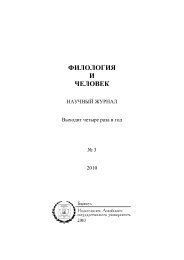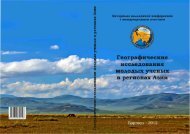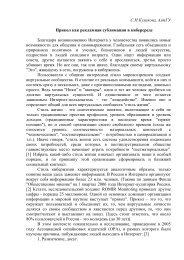Erasmus Mundus Action 1 Compendium 2009 - EACEA - Europa
Erasmus Mundus Action 1 Compendium 2009 - EACEA - Europa
Erasmus Mundus Action 1 Compendium 2009 - EACEA - Europa
Create successful ePaper yourself
Turn your PDF publications into a flip-book with our unique Google optimized e-Paper software.
VIBOT<br />
European Master in Vision and Robotics<br />
<strong>Erasmus</strong> <strong>Mundus</strong> Masters Courses<br />
Duration: 2 years<br />
Course description:<br />
The European master on Computer Vision and Robotics strives to meet the present need for quality<br />
control and automation of industrial processes. It also confronts the increasing importance of medical<br />
imagery in the field of health. The course aims to provide professional qualifications for robotics,<br />
computer vision, image processing and medical imaging either in public laboratories or private<br />
research companies. The two-year programme proposed is divided into four semesters: the first<br />
semester is spent at the Heriot-Watt University (United Kingdom); the second semester takes place at<br />
the University of Girona (Spain); the third semester is hosted by the University of Burgundy (France);<br />
the fourth semester focuses on the master thesis carried out in a research lab or an enterprise<br />
involved in the consortium.<br />
VIBOT students cover a wide range of study areas, learning the basics of signal and image processing<br />
and becoming familiar with the tools and methods of computer vision (compression, segmentation,<br />
real-time, shape recognition, 3D vision, etc). They will work on robotics and medical imaging. The final<br />
semester offers practical research experience in one of the laboratories of the university members of<br />
the consortium (for non-European students) or in a laboratory of a third-country university partner (for<br />
European students). Students may also choose to do a vocational training period. Companies such as<br />
BAE (UK), Barco (UK, Belgium), Luxscan (Luxembourg), IEE (Luxembourg), ORNL (USA), CSIRO<br />
(Australia), AREVA( Germany, France), Seebyte (UK), Continental (Germany, France)… are regularly<br />
hosting VIBOT students for Internships.<br />
Each university articulates its offer of courses on the basis of its own approach, so that students<br />
benefit from different cultural and scholarly perspectives. Classes are taught in English by eminent<br />
researchers from the three laboratories: SIG/OSL at Heriot-Watt, VICOROB at Girona, Le2i at Le<br />
Creusot. An introduction to Scottish, Spanish and French culture and language is also offered to the<br />
students. The student population is between 30 and 40 each year, with an average professor/student<br />
ratio of approximately 1 professor to 5 students.<br />
The Master’s qualification (consisting of a joint certificate, a multiple degree and a diploma<br />
supplement) is awarded by all three universities, and countersigned by the consortium’s director.<br />
Applicants must be of excellent academic standing, and possess a solid knowledge of English. Their<br />
motivation and the relevance of the programme to the student’s professional intentions will also be<br />
taken into consideration.<br />
Website: http://www.vibot.org<br />
Partners:<br />
University of Burgundy, France (Co-ordinating Institution)<br />
Heriot-Watt University, United Kingdom<br />
University of Girona, Spain<br />
Contact:<br />
Fabrice Meriaudeau<br />
Université de Bourgogne<br />
Centre Universitaire Condorcet<br />
720, avenue de l'Europe<br />
71200 Le Creusot, FRANCE<br />
f.meriaudeau@iutlecreusot.u-bourgogne.fr<br />
139






